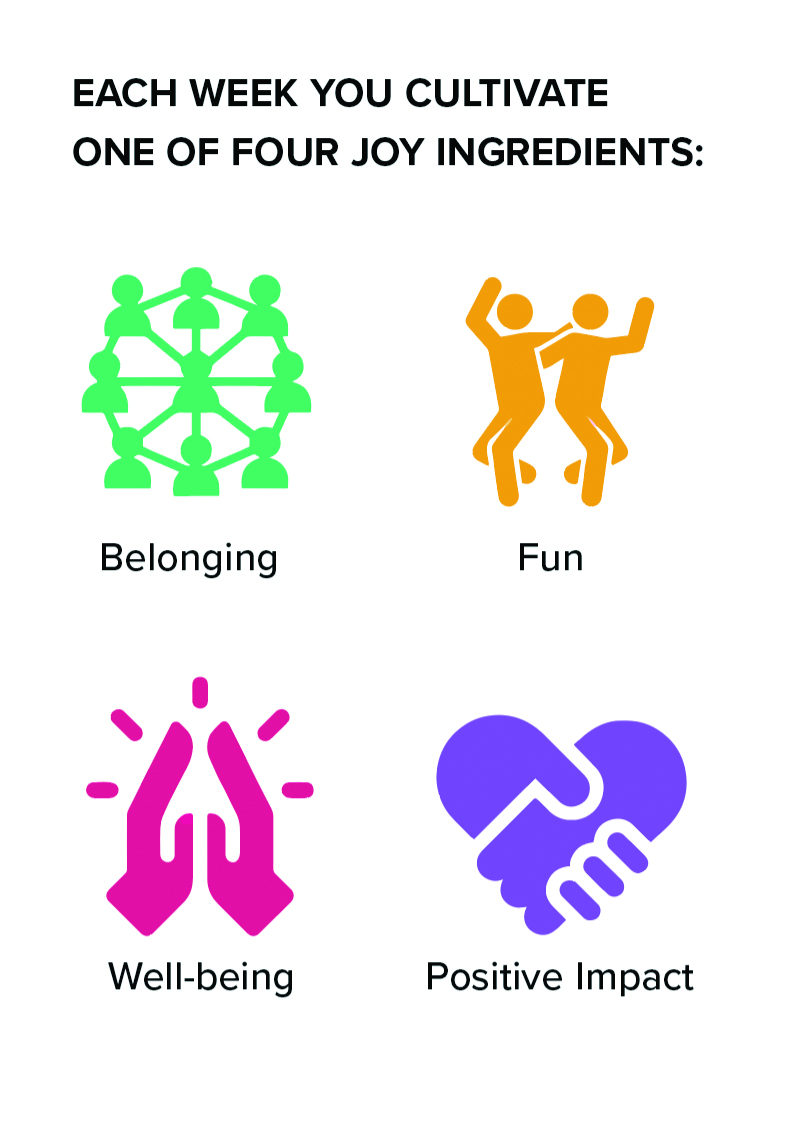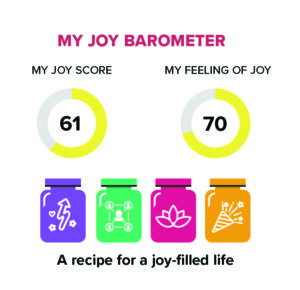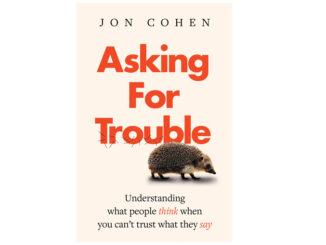


By Anastasia Kravchenko, Marketing Lead, The Art and Science of Joy Company, Espoo, Finland, anastasia@theartandscienceofjoy.com
Contributing Authors:
Andrew Cannon, Co-Founder of the Art and Science of Joy and EQJOY Co.
Debby Schlesinger-Hellman, Co-Founder of the Art and Science of Joy and EQJOY Co.
Introduction
“The world is going through great transformation, and many people are struggling with all the negativity and the fear. The Year of Joy is an opportunity for people who want to say no to fear and yes to joy, to come together and harvest more joy-filled lives, for their own benefit and for the benefit of those they love, as well as society and the planet more broadly.”
—Andrew Cannon, co-founder of The Art and Science of Joy
The Year of Joy (YOJ) initiative was launched on January 17, 2023, by The Art and Science of Joy. Co-founded by Andrew Cannon, who resides in Finland (the “happiest country in the world”), and Debby Schlesinger-Hellman, the initiative aims to bring the importance, power, and need for more joy to the forefront of our lives. Grounded in scientific research and data, the YOJ community offers a comprehensive “Recipe for Joy,” consisting of four core elements: well-being, belonging, positive impact, and fun. This article delves into the transformative impact of joy within research and broader societal contexts, drawing insights from the YOJ initiative and its innovative tools like the “Joy Barometer.”
The Importance of Joy
As confirmed by Barbara Fredrickson, a noted expert in the field of positive psychology, joy isn’t merely a fleeting emotion; it has tangible benefits such as improved cognitive function and enhanced creativity (Fredrickson, 2001). A meta-analysis of 225 studies underscores these claims, demonstrating that joyful individuals are more productive and live longer lives (Mission Joy).
These insights gain heightened importance in an era marked by a loneliness epidemic, making the U.S. Surgeon General’s recent emphasis on mental health particularly crucial. The Surgeon General astutely observes that emotional well-being transcends the mere absence of mental illness; it encompasses positive attributes like joy and satisfaction. Seeking joy has implications beyond the individual experience; companies that seek to cultivate it stand to benefit. Data substantiates that work environments infused with joy witness a 21 percent increase in productivity and a 22 percent surge in profitability (Harter, Schmidt, & Keyes, 2003).

Joy In Action
Far from being a mere emotional luxury, joy is rapidly gaining recognition as a pivotal factor in both personal and societal well-being. It merits serious consideration as a central metric in research methodologies, healthcare initiatives, and broader public policy frameworks. By integrating joy into the research process, the experience can become more enjoyable for researchers and participants alike; it can potentially enhance the quality and impact of the research itself. Given that 40 percent of our daily actions directly influence our joy, the implications for both research and life are profound (Sheldon & Lyubomirsky, 2006).
Empowering Research Participants through Joy
Traditional research methodologies often put the spotlight on data collection and statistical significance, sometimes overlooking the experience of the participants themselves. However, the YOJ online community offers a paradigm shift by emphasizing the importance of joy and enjoyment as integral elements of the research process.
What is the Year of Joy?
It is an exciting and transformative journey of 52 weeks, designed to make joy your intention for the year. This program will help you to navigate the complexities of life with a sense of joy and optimism, becoming a driving force that brings positive change not only for yourself but also for others and the planet.

Innovative researchers across different fields are beginning to acknowledge the advantages of centering participant enjoyment in their studies. For instance, the positive psychology movement sheds light on the significance of positive emotions in fostering engagement and enhancing the learning experience, which can be extended to the realm of academic and clinical research. In particular, the role of positive emotions and engagement has been explored in the context of academic settings, where fostering a sense of enjoyment and engagement among students has been associated with better learning outcomes (Hammill, J., Nguyen, T., & Henderson, F., 2022).
Moreover, the importance of participant engagement in research settings has been underscored in various studies, highlighting that effective engagement strategies not only improve recruitment and retention rates but also contribute to the overall success and efficiency of the study. These findings align with the broader notion of considering participant enjoyment as a crucial metric for evaluating the success of a study alongside traditional metrics such as validity and reliability (Wang, Song, Jiao, O’Brien, Ubel, Wang, & Scales, 2021).
In the YOJ community, the focus on joy is not merely a theoretical posture but a lived experience. Researchers actively employ tools like the “Joy Barometer” to not only measure but also enhance the joy experienced by participants. This dual role of joy—as both a metric and an intervention tool—redefines what success looks like in a study setting.
LEARN MORE ABOUT “THE YEAR OF JOY”
The Art and Science of Joy website: https://theartandscienceofjoy.com
Sign up link to the Year of Joy community: www.yearofjoy.live/surveys/236/
external_participate/90904
YOJ Podcasts with the experts: https://theartandscienceofjoy.com/captivate-
category/the-year-of-joy
The Year of Joy Methodology
The Year of Joy is designed as a full-year initiative of an online community. This extended timeframe allows for a longitudinal study of joy, providing members ample time to integrate joy-building habits into their lives.
- Community Scope and Participation: The YOJ community has around 4,000 active members and is growing steadily. The community is open to participants worldwide.
- Community Engagement and Moderation: Participants engage in dynamic weekly activities and discussions, which are moderated by “Joy Superpower” experts who specialize in areas like empathy, sleep, and nutrition. This ensures that the platform is not just engaging but also guided by experts. In addition to these experts, professional community moderators ensure that the user experience is seamless and enriching. Organizations like Scoot Insights, that are also sponsors of the Year of Joy, contribute by having their actual researchers involved in the community to enhance the participant experience and ensure it aligns with the initiative’s goals.
- Examples of Joy-Related Activities: A typical week in the YOJ community includes a variety of activities designed to foster joy. These range from expert tips and quick polls to more involved activities like maintaining gratitude journals and participating in community service activities.
Experiences from the Field
Researchers who have made the leap to integrate joy into their methodologies often find their work more rewarding. Beyond job satisfaction for researchers, the subjects themselves reported a more positive overall experience. Empowering research participants through joy presents a groundbreaking approach to qualitative research, elevating the importance of the human experience within the realm of scientific inquiry. As researchers and participants alike attest to the enriching effects of joy within the study environment, it is clear that the focus on happiness and well-being in research is more than just a trend—it’s a movement with the power to redefine success in research methodologies for years to come.

How to Interpret Your Joy Barometer Scorecard
- Your Joy Score is a number between 0 and 100, and shows how joyfully you are living based on your answers to the Joy Barometer survey and takes into account how important you consider each joy ingredient to be as well as your level of mastery.
- Your Feeling of Joy number shows how joyfully you feel you are living today on a scale 0 to 100 (0 = not at all, 100 = extremely).
- Use your Joy Barometer Scorecard to help you set your intentions, goals, and plans for bringing more joy to your own life, as well as the lives of others. See you in the Year of Joy community for your regular dose of inspiration and empowerment.
The Significance of Cultivating Joy for Researchers Is Immense
The structured, routinized nature of research may not appear to be fertile ground for joy, but the significance of cultivating joy for researchers is far from trivial. A joyful researcher is not just a content individual but also a more effective one. According to a study, a positive inner work life significantly contributes to high-performance metrics, including creativity and productivity (Amabile & Kramer, 2011).
Actions and Recommendations for Cultivating Joy
Practical Steps for Individuals to Enhance Their Own Joy
- Well-Being: Prioritize self-care activities that nourish your emotional, mental, and physical health. According to a study by Lyubomirsky and Layous (2013), activities like expressing gratitude can significantly elevate one’s sense of well-being and joy.
- Belonging: Foster genuine connections with others. Holt-Lunstad et al. (2010) found that strong social connections can increase lifespan by 50 percent, largely due to the joy derived from relationships.
- Positive Impact: Engage in acts of kindness and community service. Research by Post (2005) indicates that altruistic behaviors can lead to increased feelings of joy and life satisfaction.
- Fun: Don’t forget to incorporate elements of play and humor into your life. A study by McGhee (2010) suggests that humor can significantly reduce stress and increase feelings of joy.
Productivity: The YOJ community’s focus on positive feedback and joy correlates with higher engagement levels both for researchers and participants, as seen in Scoot Insight’s Q2 Sprint. Researchers who are joyful are more likely to be engaged and focused, leading to higher levels of productivity.
Creativity: Positive emotional states act as a catalyst, stimulating creative thinking. This is evident in the YOJ community, where members felt that the “timing was just right” and that the community was a “ray of sunshine,” inspiring them to be more creative and self-reflective.
Burnout Prevention: Joy serves as a buffer, mitigating the stress and high levels of burnout that are common in research careers. The YOJ community members joined for the content benefits and the opportunity to be part of something bigger than themselves, which has been a positive experience for them.
Tips for Bringing More Joy into Research Work
- Create a Positive Work Environment: Atmosphere matters. The ambiance of your workspace can significantly influence your mood and, by extension, your productivity. The YOJ community thrived because it put a “human face on the market research company of warmth and community.”
- Incorporate Elements of Play: Research is a serious endeavor, but elements of play can break the monotony. The YOJ community engaged its members through forums and interactive sessions, injecting a dose of creativity into the process.
- Celebrate Small Victories: Research is a marathon, not a sprint. Small victories may seem inconsequential, but they provide the emotional sustenance to keep going. The YOJ community focused on the “power of positive feedback,” which aligns well with this principle.
Conclusion: Elevating Research through the Power of Joy
The integration of joy into research methodologies represents a paradigm shift with far-reaching implications for both researchers and participants. The Year of Joy community exemplifies this approach, employing innovative tools like the “Joy Barometer” to convert emotions into actionable data. As qualitative research evolves, the incorporation of emotional metrics like joy is setting new standards for understanding human behavior and community interaction. This focus on joy has the potential to revolutionize various research applications, from mental health to consumer behavior and policy governance, thereby redefining what success looks like in research settings.
References
Fredrickson, B.L. (2001). The role of positive emotions in positive psychology: The broaden-and-build theory of positive emotions. American Psychologist, 56(3), 218–226.
Hammill, J., Nguyen, T., & Henderson, F. (2022). Student engagement: The impact of positive psychology interventions on students. Active Learning in Higher Education, 23(2), 129-142. https://doi.org/10.1177-146-9787420950589
Harter, J.K., Schmidt, F.L., & Keyes, C.L. (2003). Well-being in the workplace and its relationship to business outcomes: A review of the Gallup studies. In C.L. Keyes & J. Haidt (Eds.), Flourishing: Positive psychology and the life well-lived (pp. 205–224). American Psychological Association.
Lyubomirsky, S., King, L., & Diener, E. (2005). The benefits of frequent positive affect: Does happiness lead to success? Psychological Bulletin, 131(6), 803–855.
Mission Joy, https://missionjoy.org/science 2022, The JOY Film LLC
Ochieng, C.A., Minion, J.T., Turner, A. et al. What does engagement mean to participants in longitudinal cohort studies? A qualitative study. BMC Med Ethics 22, 77 (2021). https://doi.org/10.1186/s12910-021-00648-w
Sheldon, K.M., & Lyubomirsky, S. (2006). How to increase and sustain positive emotion: The effects of expressing gratitude and visualizing best possible selves. The Journal of Positive Psychology, 1(2), 73–82.
Wong, C.A., Song, W.B., Jiao, M., O’Brien, E., Ubel, P., Wang, G., Scales, C.D. Strategies for research participant engagement: A synthetic review and conceptual framework. Clin Trials. 2021 Aug;18(4):457-465. doi: 10.1177-174-0774521-101-1068. Epub 2021 May 20. PMID: 34011179.




